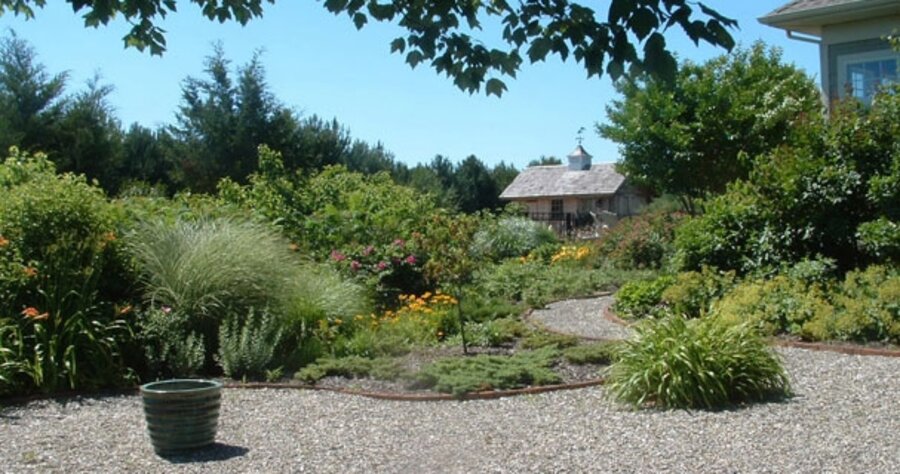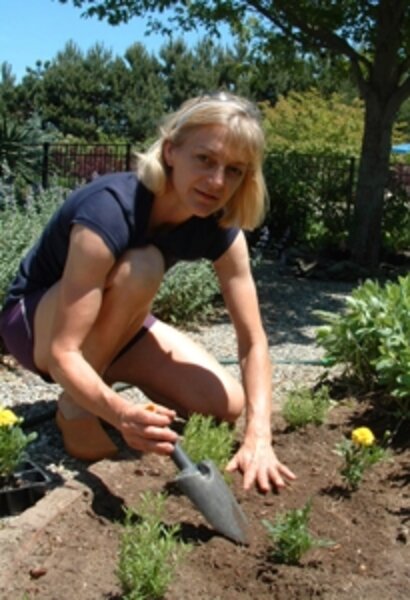She grows pretty plants by the seashore
Loading...
Gretchen Ferrante, director of the Nature Center of Cape May, in New Jersey, has filled her personal garden with plants suitable for the harsh seashore conditions: prevailing winds, sandy soil, salty air, and the unpredictable threat of a nor’easter.
Ms. Ferrante’s garden, a two-acre property a mile and a half from the Atlantic Ocean, draws you in, meandering from one surprise to another.
Included are herbaceous perennials – coneflower, yarrow, sedum, Russian sage, Montauk daisy – as well as colorful annuals such as zinnias, marigolds, nasturtiums, and four o’clocks – and herbs, shrubs, and trees.
All can withstand mercurial coastal conditions.
Planning and planting is still an evolving process, she says.
Ferrante first planted evergreens as the foundation of the garden.
“Austrian pine is seashore tolerant and makes an excellent windbreak, and eastern red cedar, another native evergreen, can tolerate seashore conditions,” she explains.
The eastern red cedar also attracts birds to the garden, with cedar waxwings and mockingbirds particularly drawn to the plant’s bluish berries or cones.
Butterfly bush, bee balm, joe-pye weed, orange butterfly weed, and yarrow bring the butterflies to her garden. These plants are some of her favorites, especially when the monarchs and swallowtails alight on them.
Butterflies need specific “host” plants when they are in their larvae stage and “nectar” plants once they become butterflies. So she recommends planting a variety of host and nectar plants and refraining from using pesticides.
As many as 40 caterpillars have been seen feasting on her parsley, a good host plant. She suggests planting fennel and dill, favorite host plants, in several spots in the yard if you want to harvest some herbs for yourself.
Ornamental and native grasses populate the garden.
“The grasses can be the showstoppers in the winter garden, blowing and adding movement to an austere landscape,” she says. “I especially like switch grass, a native to eastern salt marshes, and another favorite is native Indian grass with blue-green leaves sending up seed heads in late summer.”
Native shrubs lend another dimension to Ferrante’s winter garden. “If you want birds coming to your garden, 30 or more species of birds are drawn to bayberry’s waxy gray berries,” she says.
Her garden has two varieties of viburnum – arrowwood and American cranberry. Both shrubs are attractive in spring when cloaked in white blossoms and in fall, when covered with showy red foliage. Their berries also supply food for visiting birds.
When choosing plants for your landscape, Ferrante recommends learning how the shape of the tree or shrub will appear when it drops its leaves. “Consider its growing habit, bark color, and texture and whether it arches, grows upright, grows low and spreads,” she says.
Those qualities can add much interest to the winter garden.
Crape myrtle is a good example. “It is a Southern favorite and looks great year-round with peeling bark and floppy seed heads,” she says.
While pointing out the silver and gray-green foliage on the herbs in her culinary garden, Ferrante notes that the silver foliage indicates a heat-tolerant plant.
Rosemary, basil, sage, oregano, thyme, and lavender thrive in her garden and are native to dry areas of the Mediterranean region where soil often is sandy or poor, similar to seashore conditions.
Hardy wild shrub roses, Rosa rugosa – exemplified by teacup-size pink or white blossoms followed in late summer by huge, brilliant orange-red hips (fruit) – border a pathway in the garden. “I once made a rose hip tart that was very good,” she says, “but [it was] time-consuming to chop the fruit.”
Another recipe she’s tried is sumac lemonade, a thirst-quenching drink made from the burgundy fruit clusters of staghorn sumac, a small native tree that’s found in several places in her garden.
The water garden is a tranquil spot. Several frogs have found a home among native waterlilies, bull rush, and soft rush. Although their late-night and early-morning croaking can be annoying, Ferrante plans to keep them.
Virginia creeper, a native ground cover, surrounds the water garden, and its blue-black berries offer another treat for the birds in the fall.
The shade garden offers Ferrante and visitors a quiet haven out of the hot summer sun. Lady fern, Virginia bluebells, and native spiderwort beckon you to come sit awhile.
“The cool palette of these native plants are soft and invite you to slow down, take a rest,” she explains, “and the foliage of the fern makes for a nice contrast.”
Selecting mostly native plants for her garden, Ferrante shows that the challenges confronting a seaside gardener can be overcome without sacrificing color and beauty. And these plants have the added advantage of attracting wildlife to the garden.






